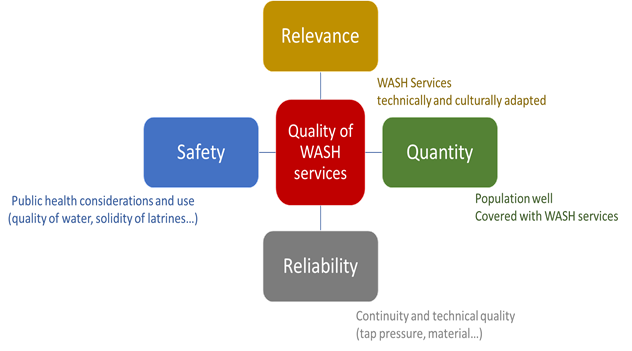...
| Expand | ||
|---|---|---|
| ||
| Expand | ||
|---|---|---|
| ||
2019 NES WASH Standards Indicators+HK_Final.xlsx |
| Expand | ||
|---|---|---|
| ||
...
Monitor
...
Analyse results of partners’ quality monitoring mechanism
Before or during the implementation phase, the coordination platform must have agreed with the partners the WASH quality assurance system, and the modalities and tools of quality monitoring. With or without the support of the coordination platform, most partners do monitor the quality of their response, with tools ranging from simple field visits done by the project manager to a full feedback and complaints mechanism. Based on the quality assurance system set up, partners must communicate transparently results of their quality monitoring to the coordination platform, who can compile results and provide consolidated analysis of the response quality.
Monitor partners response quality
Coordination platform can also directly monitor partners response quality. While self-reported indicators of service-level can be derived from a 5W matrix, this is an inadequate measure if taken alone and other tools must be used by coordination team, such as ad hoc or planned field visit and discussion with beneficiaries. To avoid creating tension with the partners, this monitoring modality should be clearly mentioned in the quality assurance system part of the SOF, and visits should be planned with partners.
UNICEF Humanitarian Performance Monitoring Toolkit contains useful examples and approaches, notably to quality monitoring, and can be found on line.
Monitor relevant response modalities
...
technical aspects of the WASH services delivered to beneficiaries
The quality of WASH services that are provided to the affected population must meet minimum standards agreed among partners. These standards are based on national standards, international standards, or contextualized depending on the context and the emergency phase. Technical standards to be applied for the response must have been agreed by partners and described in the Standards & Methodologies chapter of the WASH Cluster Strategic Operational Framework. The technical quality of the WASH services embraces four main areas: relevance, quantity, reliability and safety (see figure hereunder); One of the main source of technical quality indicators is the Sphere handbook.
The monitoring of the WASH service quality must be routinely done by the partner themselves for their program. It is recommended that partners report the results of their quality monitoring system to the WASH coordination platform, provided that this is stipulated in the agreed quality assurance system.
Depending on the agreed modalities, field-based monitoring of partners' activities can be:
- done by third parties, such as the government or a private company
- reported directly by the beneficiaries to an independent company or organization, through a feedback and complaints mechanism
- monitored through field visit by the WASH coordination team at subnationnal level etc.
A usual quality monitoring tool is the WASH Infrastructure "Spot-check", in which latrines or water points are being physically monitored using a standard check list.
Integration of key WASH quality indicators into other monitoring systems (ex: The National Health Interview Survey (NHIS), Displacement tracking Matrix (DTM) etc.), and engagement with other key clusters, can also help to flag WASH quality issues.
